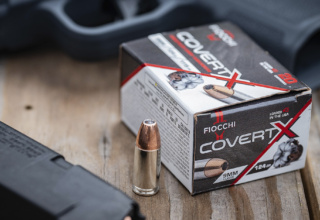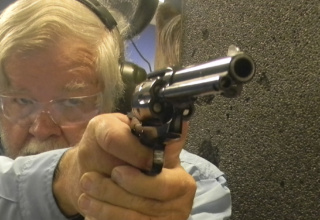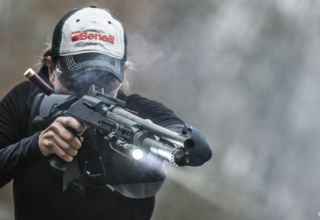There are many variables that make up the ideal EDC cartridge. The order of importance may not be what you think.
by Bob Campbell
When you make the decision to take charge of your own safety, you also assume responsibility for choosing your own gear. This means a gun belt, holster, handgun, and ammunition. Quality gear isn’t inexpensive. Proficiency at arms is purchased with a different coin.
Of the choices we make, the handgun, caliber, and ammunition are intertwined. Ammunition is the easiest and generally least expensive to change. A lot of experimentation goes into personal defense ammunition. Some of it isn’t valid and quite a bit of the claims made for ammunition are ridiculous. The claims simply don’t hold up when subjected to objective testing.
I come from a background in public safety. We tested a load extensively with the primary concern being reliability. Reliability is a million times more important than anything else. Accuracy, pressure, and resistance to the elements are also important. Only when these criteria are met will wound ballistics be considered.

Civilians often approach ammunition selection backwards and begin with wound ballistics. This is the wrong place to start. A balance of expansion and penetration is important, but reliability, a full powder burn, and accuracy are high on the list. In other words, the overall integrity of a cartridge is important.
I concentrate on 9mm and .45 ACP in carry guns and regard the .38 Special primarily as a backup. I like a general-purpose load that isn’t overly specialized. There are fragmenting loads — generally a bad idea on many points — and deep penetration loads. Some shooters like to employ different loads for summer and winter carry and even carry a different load in the backup magazine or speedloader. That is too specialized for most of us.

I like to find a cartridge that offers good control. When pressure is on the high side, the handgun frame may hold up, but that extra pressure is hard on small parts. A standard pressure load should demonstrate a full powder burn. This means all or at least most of the powder is burned in the barrel. Muzzle flash is caused by powder burning outside the barrel and is undesirable. A minimum of unburned powder will keep the handgun cleaner.
Cartridge integrity means the load should have a good crimp that prevents the bullet from being bumped into the cartridge case during the feed cycle. We sometimes load and unload a self-loader several times during the month. The cartridge must withstand several chamberings. The proofing I have described isn’t as exciting as firing bullets into water or gelatin and measuring expansion, but it must be done. Only at the end of the ammunition program will ballistic testing be worthwhile. The load should be one that works in most cases without specialization. I like to plan for the worst-case scenario. Penetration is the single most important criteria after reliability.

Unfortunately, most folks don’t put the research into their ammunition that they should.
Affordability is a valid concern. I was pleased to find Fiocchi’s 9mm 124-grain XTP for $12.89 for a 25-round box at Cheaperthandirt.com. Fiocchi enjoys an excellent reputation for quality and accuracy, which I’ve had the opportunity verify.
FMJ loads are good for proofing various handguns. If the handgun malfunctions during a test, I need to know if the magazine, handgun, or ammunition is at fault. Quality ammunition eliminates one variable. I have handloaded for many years and understand how important overall length is to ensure reliable feeding. In fact, it’s as important as the bullet nose profile in terms of feeding.

I take testing loads seriously because when used in a defensive firearm, it can be a life or death conclusion. I recently tested several Fiocchi personal defense loads with good to excellent results. First came the popular 9mm. Affordable, reliable, and with good performance, the 9mm is a great personal defense choice but it demands careful load selection for effectiveness.
I used three of my favorite 9mm handguns to test two Fiocchi 9mm loads. These pistols included the CZ P10S, Springfield XDS, and Glock 19. All the pistols fed reliably. The compact CZ delivered the best accuracy at 15 yards, with the pistols demonstrating five shot groups of 1.9 to 2.5 inches. In the different barrel lengths, the Fiocchi 115-grain load went 1130, 1150, and 1170 fps. Penetration in water was 16-18 inches and expansion ranged from .52 to .55 inches. This is excellent performance. While the loads are good performers, recoil is modest.

Moving to the 124-grain load, also using an XTP bullet, performance was slightly different. Accuracy was a bit better, with the best group at 1.75 inches, again in the CZP10S. The CZP10S and Springfield XDS exhibited almost the same velocity at 1101 and 1104 fps, respectively, with the GLOCK clocking 1145 fps over the RCBS Ammomaster Chronograph. The standard deviation (difference in velocity between shots) was a low 12 fps. Penetration is 18-20 inches and expansion .50-.54 inches. I like this load a lot. Some like higher velocity, others greater penetration. Both are good choices.

I have several .38 Special revolvers for back up carry, trail use, and occasionally primary carry. The .38 Special is well suited to personal defense if we have a strong load that offers good expansion and penetration.
Fiocchi offers .38 Special +P loads in both 110- and 124-grain weight. The 110-grain has traditionally been designed for less recoil while maintaining good velocity. I fired these loads in two Military and Police revolvers — one with a four-inch barrel and the other with a two-inch barrel. I was surprised that the 125-grain load averaged 1060 fps in the four-inch barrel revolver. This is considerably faster than most factory loads. It maintained 980 fps from the two-inch barrel revolver. Penetration averaged 18 inches in water, with expansion at .60-.62 inches. I like this load. It maintains most of its velocity in a snubnose revolver and offers good performance.

The 110-grain +P was even faster at 1080 fps. Snubnose performance fell off to 940 fps — common in these handguns, but still very fast. Most 110- to 125-grain factory JHP loads struggle to break 900 fps in a snubnose revolver. The 110-grain .38 expanded to .54 inches and penetrated 18-20 inches of water. I like the heavier load best. At a long 25 yards, the four-inch barrel revolver turned in a solid two-inch five-shot group.

I have used the Fiocchi 200-grain XTP load in .45 ACP extensively for accuracy and reliability testing but until recently I have neglected expansion and penetration testing. I used two of my favorite personal guns, a Springfield Armory Operator and Guncrafter Industries Commander for the test. Performance is exceptional at 970 fps in the Springfield five-inch barrel and 940 fps in the Guncrafter four-inch barrel. Accuracy testing was done at 25 yards. The Guncrafter cut a 1.4-inch 25-yard group with the Springfield. This is more than accurate enough for any conceivable chore. As for expansion and penetration, the 200-grain XTP penetrated 18 inches average in either handgun. Expansion was .68 inches at the faster velocity and .64 inches in the Commander barrel length — very consistent in either. The 230-grain Fiocchi Extrema, using the XTP bullet, averaged 820 fps in the Springfield and 780 fps in the Guncrafter. These two 1911s vied for best accuracy results with the Guncrafter Commander cutting a five-shot, 1.5-inch group at 25 yards. Expansion was consistent at .68 inches for 20 inches of penetration.
These are hard hitting loads with plenty of momentum.

The primary criteria in choosing a defense load is reliability. Once you have reliability, you should look at considerations such as muted muzzle flash and accuracy. The final criteria — and it is very important — will be wound ballistics. The loads I have tested and trust in my carry guns have provided exceptional performance.
Before you adopt a load, put them up against the same standard I have outlined. You may have a load that falls short or one that excels, but in the end, you have proofed a choice and can trust it.












